
What Is a Karen Haircut and 5 Karen Haircuts to Avoid
The "Karen" haircut has taken the internet by storm, sparking debates and conversations about its origin, meaning, and cultural implications. Often associated with a specific stereotype, the Karen haircut has become more than just a hairstyle—it's a symbol of entitlement and negative behavior. However, it's essential to look beyond stereotypes and understand that haircuts should not define a person's character.
In this blog, we will explore the Karen haircut trend, its history, how it got its name, and why it's crucial to avoid using hairstyles to stereotype or judge individuals. Let's dive in with an open mind and shed light on the complexities surrounding this viral haircut.
What is a Karen Haircut?
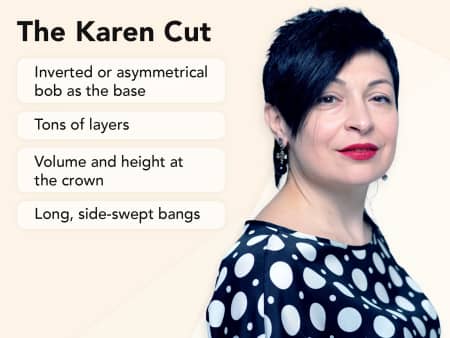
The Karen haircut refers to a specific hairstyle that gained popularity during the early 2000s. It features a short, choppy, and asymmetrical cut with longer strands in the front and shorter layers at the back.
The style often includes side-swept bangs and may involve a highlighted or two-toned color effect. The Karen haircut's defining features are its angular layers and angled fringe, creating a bold and modern look.
The Karen Meme and Stereotype
The term "Karen" became popular on social media as a meme used to describe a certain type of person, typically portrayed as entitled, demanding, and confrontational. The Karen stereotype often represents someone who complains or asks to speak with the manager in various situations, behaving in an entitled manner.
Unfortunately, this stereotype has extended beyond the haircut to encompass a broader set of traits that are not reflective of the hairstyle alone.
The Origin of the Term "Karen"
The origin of the "Karen" meme and the term's association with the specific haircut are not entirely clear. It is believed that the meme originated on internet forums, and its usage grew over time on various social media platforms.
The name "Karen" was likely chosen randomly to represent a generic name for the stereotype. As the meme became more widespread, it began to encompass various negative behaviors and attitudes that the "Karen" archetype was thought to exhibit.
5 Hairstyles to Avoid If You Don’t Want to Look Like a Karen
1. The original Karen cut
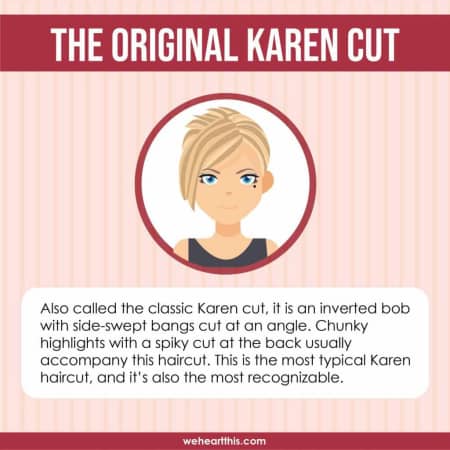
Source: weheartthis.com
The original Karen cut, also known as the classic Karen cut, is an inverted bob with side-swept bangs that are cut at an angle.
This haircut is generally paired with chunky highlights and a spiky cut at the back. This is the most common Karen hairstyle, and it's also the most recognizable.
It's a popular hairstyle among older ladies, and it's easy to see why. It's low-maintenance, easy to style, and doesn't require much work to look fantastic. If you don't want to be linked with a "Karen" haircut, the kinky, unkempt style is best avoided.
2. Brassy blonde highlights with a tossed-back cut
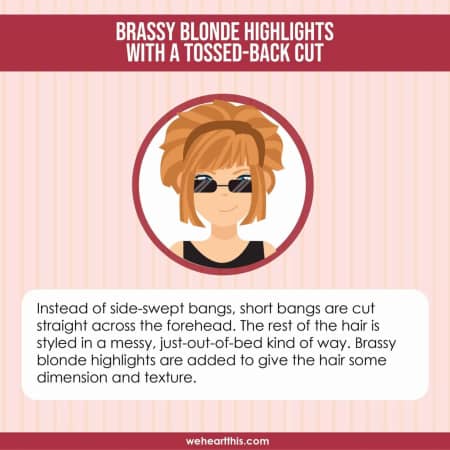
Source: weheartthis.com
Short bangs are cut directly across the forehead rather than side-swept bangs. The rest of the hair is styled in a haphazard, just-out-of-bed manner.
Brassy blonde highlights are used to add dimension and structure to the hair. The back is frequently cut short and layered, with the hair thrown back carelessly.
3. Tiger stripe hair color with a pixie cut
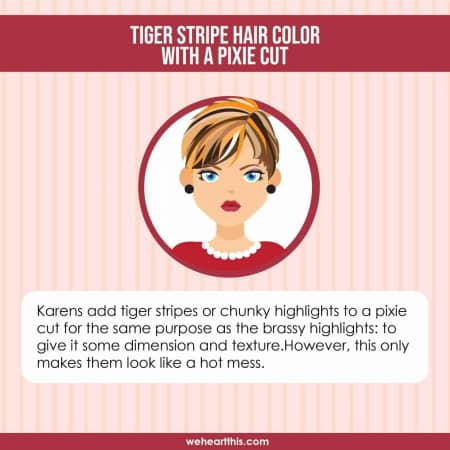
Source: weheartthis.com
Pixie haircuts have been popular for many years.There's no need to reinvent the wheel, but some individuals use tiger stripes in their hair to get the same effect as brassy blonde highlights: to add dimension and structure.
The issue with this hairstyle is that it can appear overly cluttered. When paired with tiger stripe hair, it might look like a hot mess. In dark and medium brown hair hues, harsh, loud highlights are alternated to create an edgy tiger-like impression, making it one of the worst haircuts for women.
If you have a pixie cut, skip the tiger stripes and opt for the trendiest hair colors of the season.
4. Too much volume on the crown with a short length cut
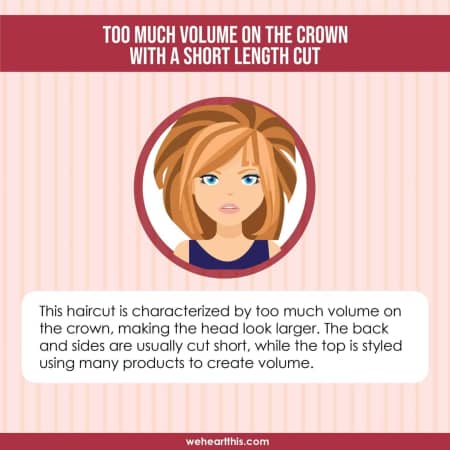
Source: weheartthis.com
This hairstyle is distinguished by enormous volume on top of the head, which makes the head look larger. The back and sides of the head are normally cut quite short, while the top of the head is heavily volumized. As a result, this haircut is known as a beehive bob.
This haircut is no longer fashionable. The beehive bob was fashionable in the 1960s, but if you don't know how to maintain it, it's best to leave it in the past. This hairstyle should be avoided if you have a round face. It will simply make your head appear larger and rounder.
We recommend a layered haircut for a tousled look. You can also use a volumizing mousse to add volume to your hair. There are many more effective ways to achieve volume and a bob than Karen's haircut.
5. Spiky cut
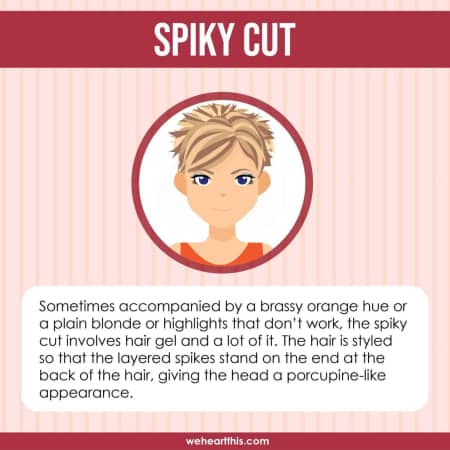
Source: weheartthis.com
The spiky cut, which is sometimes accompanied by a brassy orange hue or a plain blonde or highlights that don't work, involves a lot of hair gel. The layered spikes are arranged so that they stand on the end at the rear of the hair, giving the head a porcupine-like appearance.
This was an edgy and sophisticated look in the 2000s. However, in recent years, it has appeared out of date.Unless you want to go for a throwback vibe, avoid this hairdo. In that case, all power to you.
A voluminous layered haircut with a mild ombre tint is an excellent method to refresh your look without looking like you're harassing black folks.
Breaking the Stereotype
As the Karen haircut meme continues to circulate on the internet, it's essential to challenge the stereotype and promote understanding and empathy. Remember that making assumptions based on appearances or hairstyles is unfair and unjust.
Hairstyles are not indicators of a person's worth, character, or behavior. It's crucial to treat everyone with respect and kindness, recognizing that we all have unique stories and experiences.
Conclusion
The Karen haircut trend may have captured the internet's attention, but it's essential to remember that hairstyles should not be used to stereotype or define individuals. Let's embrace diversity, celebrate individuality, and avoid perpetuating harmful stereotypes. Instead, let's promote empathy, respect, and a more inclusive understanding of others.
